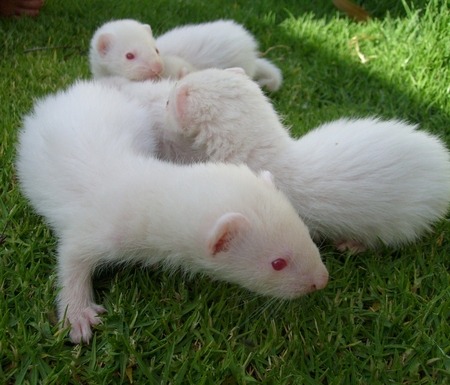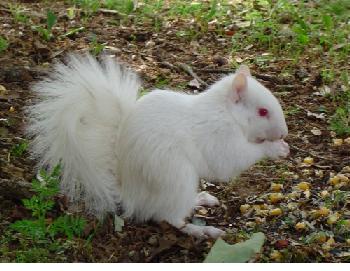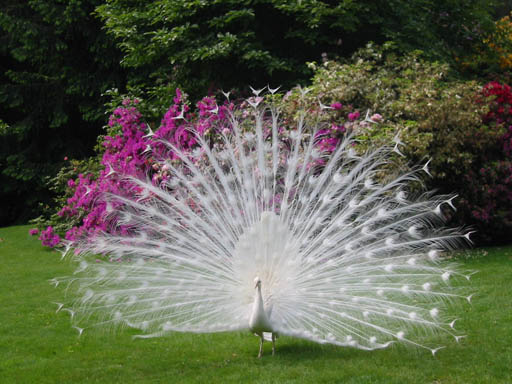|
|
|---|
Wednesday, April 7, 2010
One kind of "wild animal" that Mom saw at the zoo was New Guinea Singing Dogs, which do not seem very much like wild animals, really, since they are actually just classified as a subspecies of regular dogs. Some people even have New Guinea Singing Dogs in their homes as pets, but if you have one, it has to be well-socialized and trained and stuff, plus you have to have a good fence because NGSDs are escape artists.
Here is a photo that Mom took of one of these dogs at the zoo. There are two of them there, and when Mom saw them on Saturday, they seemed very restless and maybe bored because they were just trotting around and around their little yard where they live. You can tell they do this a lot because they have made paths.
New Guinea Singing Dogs are from the country of New Guinea, which if you are not too good at geography, is just north of Australia. New Guinea has a lot of forests and stuff, so it's hard to know how many animals are living there. I was shocked to learn that no one has ever studied New Guinea Singing Dogs in the wild, so we don't know how they live or what the eat or anything like that. We don't know how many there even are, but every once in a while somebody sees one or two of them, so there are probably a few left, but not very many. In fact, there are so few of them that the scientists say they are CRITICALLY ENDANGERED in the wild, which is just one step away from being EXTINCT.
So anyway, most of the NGSDs of the world are not in New Guinea anymore. And the way this happened was that in the 1950s, a man named Sir Edward Hallstrom took a pair of singers from New Guinea to the Taronga Zoo in Sydney, Australia. And then in 1976, five singers were captured and taken to Germany. Most of the NGSDs in America now have that Australian pair and one German dog as their ancestors. If you do the math on this, you will see that it adds up to a very small gene pool.
At first, people thought New Guinea Singing Dogs were a separate species from regular dogs, but later, they realized that they were related to dingoes, and that they are a subspecies of the domestic dog. So zoos didn't keep them in their breeding programs because they thought of them as regular old dogs. But now there are some people who are trying to save the singers, and there are about 300 in captivity.
If you have a NGSD, you can register it with the United Kennel Club, and you can even enter it in a dog show. The NGSD is part of the Sighthounds and Pariah Group. You can also register a singer with the American Rare Breed Association, in the Spitz and Primitive Group.
NGSDs are very energetic and alert. If they are socialized properly, they get used to humans and bond with their humans. They are kind of aloof with strangers, but this is true for lots of basenjis, too, so I'd say there is nothing wrong with being that way. Singers have really flexible bodies, so they can squeeze through all kinds of narrow spaces. Also they have a strong prey drive, just like basenjis.
Of course, you may be wondering why these dogs are called "singing dogs," and now I will tell you. Instead of barking, NGSDs howl, like wolves, except that they can vary the pitch of their howling, so it sounds more like singing. If you would like to hear a chorus of chorus of New Guinea Singers, click here: http://newguinea-singing-dog-conservation.org/Tidbits/sing.wav
I hope that the people who are trying to save the New Guinea Singing Dogs from extinction are successful. It would be very sad for them to be all gone from the world. I asked Mom if we could have one at our house, but she said no, because we already have our Legal Limit of Dogs. And anyway, it would be hard to get one because there are so few of them around.
Here is a photo that Mom took of one of these dogs at the zoo. There are two of them there, and when Mom saw them on Saturday, they seemed very restless and maybe bored because they were just trotting around and around their little yard where they live. You can tell they do this a lot because they have made paths.
New Guinea Singing Dogs are from the country of New Guinea, which if you are not too good at geography, is just north of Australia. New Guinea has a lot of forests and stuff, so it's hard to know how many animals are living there. I was shocked to learn that no one has ever studied New Guinea Singing Dogs in the wild, so we don't know how they live or what the eat or anything like that. We don't know how many there even are, but every once in a while somebody sees one or two of them, so there are probably a few left, but not very many. In fact, there are so few of them that the scientists say they are CRITICALLY ENDANGERED in the wild, which is just one step away from being EXTINCT.
So anyway, most of the NGSDs of the world are not in New Guinea anymore. And the way this happened was that in the 1950s, a man named Sir Edward Hallstrom took a pair of singers from New Guinea to the Taronga Zoo in Sydney, Australia. And then in 1976, five singers were captured and taken to Germany. Most of the NGSDs in America now have that Australian pair and one German dog as their ancestors. If you do the math on this, you will see that it adds up to a very small gene pool.
At first, people thought New Guinea Singing Dogs were a separate species from regular dogs, but later, they realized that they were related to dingoes, and that they are a subspecies of the domestic dog. So zoos didn't keep them in their breeding programs because they thought of them as regular old dogs. But now there are some people who are trying to save the singers, and there are about 300 in captivity.
If you have a NGSD, you can register it with the United Kennel Club, and you can even enter it in a dog show. The NGSD is part of the Sighthounds and Pariah Group. You can also register a singer with the American Rare Breed Association, in the Spitz and Primitive Group.
NGSDs are very energetic and alert. If they are socialized properly, they get used to humans and bond with their humans. They are kind of aloof with strangers, but this is true for lots of basenjis, too, so I'd say there is nothing wrong with being that way. Singers have really flexible bodies, so they can squeeze through all kinds of narrow spaces. Also they have a strong prey drive, just like basenjis.
Of course, you may be wondering why these dogs are called "singing dogs," and now I will tell you. Instead of barking, NGSDs howl, like wolves, except that they can vary the pitch of their howling, so it sounds more like singing. If you would like to hear a chorus of chorus of New Guinea Singers, click here: http://newguinea-singing-dog-conservation.org/Tidbits/sing.wav
I hope that the people who are trying to save the New Guinea Singing Dogs from extinction are successful. It would be very sad for them to be all gone from the world. I asked Mom if we could have one at our house, but she said no, because we already have our Legal Limit of Dogs. And anyway, it would be hard to get one because there are so few of them around.
0 Comments:
Subscribe to:
Post Comments (Atom)




















